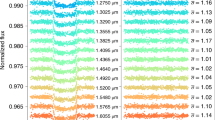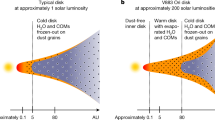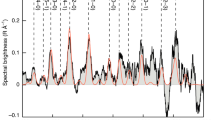Abstract
Since 1995, planets with masses comparable to that of Jupiter have been discovered around approximately 60 stars1. These planets have not been seen directly, but their presence has been inferred from the small reflex motions that they gravitationally induce on the star they orbit; these motions result in small periodic wavelength shifts in the stellar spectrum. The presence of analogues of the smaller bodies in our Solar System cannot, however, be determined using this technique, because the induced reflex motions are too small—so an alternative approach is needed. Here we report the observation of circumstellar water vapour around the ageing carbon star IRC+10216; water is not expected in measurable quantities around such a star. The only plausible explanation for this water is that the recent evolution of IRC+10216, which has been accompanied by a prodigious increase in its luminosity, is causing the vaporization of a collection of orbiting icy bodies—a process considered in an earlier theoretical study2.
This is a preview of subscription content, access via your institution
Access options
Subscribe to this journal
Receive 51 print issues and online access
$199.00 per year
only $3.90 per issue
Buy this article
- Purchase on Springer Link
- Instant access to full article PDF
Prices may be subject to local taxes which are calculated during checkout


Similar content being viewed by others
References
Marcy, G. W. & Butler, P. R. Planets orbiting other suns. Publ. Astron. Soc. Pacif. 112, 137–140 (2000).
Stern, S. A., Shull, M. J. & Brandt, J. C. Evolution and detectability of comet clouds during post-main-sequence stellar evolution. Nature 345, 305–308 (1990).
Woolf, N. J., Schwarzschild, M. & Rose, W. K. Infrared spectra of red giant stars. Astrophys. J. 140, 833–852 (1964).
Neufeld, D. A., Feuchtgruber, H., Harwit, M. & Melnick, G. J. Infrared Space Observatory observations of far-infrared rotational emission lines of water vapor toward the supergiant star VY Canis Majoris. Astrophys. J. 517, L147–L150 (1999).
Millar, T. J., Herbst, E. & Bettens, R. P. A. Large molecules in the envelope surrounding IRC+10216. Mon. Not. R. Astron. Soc. 316, 195–203 (2000).
Williams, P. G. & White, G. J. Sub-millimetre molecular lines in the circumstellar envelope of IRC+10216. Astron. Astrophys. 266, 365–376 (1992).
Pickett, H. M. et al. Submillimeter, millimeter, and microwave spectral line catalog. J. Quant. Spectrosc. Rad. Transfer 60, 883–890 (1998).
De Lucia, F. C. & Helminger, P. A. Millimeterwave spectroscopy of active laser plasmas; the excited vibrational states of HCN. J. Chem. Phys. 67, 4262–4267 (1977).
Skinner, C. J. et al. Modelling the dust and gas outflows from IRC+10216 – I. Ground-based and airborne observations. Mon. Not. R. Astron. Soc. 302, 293–304 (1999).
Glassgold, A. E. Circumstellar photochemistry. Annu. Rev. Astron. Astrophys. 34, 241–278 (1996).
Willacy, K. & Cherchneff, I. Silicon and sulfur chemistry in the inner wind of IRC+10216. Astron. Astrophys. 330, 676–684 (2000).
Herpin, F. & Cernicharo, J. O-bearing molecules in carbon-rich proto-planetary objects. Astrophys. J. 530, L129–L132 (2000).
Jewitt, D. & Luu, J. X. in Protostars and Planets IV (eds Mannings, V., Boss, A. P. & Russell, S. S.) 1201–1229 (Univ. Arizona Press, Tucson, 2000).
Cernicharo, J. et al. The ISO/SWS spectrum of IRC+10216: the vibrational bands of C2H2 and HCN. Astrophys. J. 526, L41–L44 (1999).
Cernicharo, J. et al. The ISO/LWS far infrared spectrum of IRC+10216. Astron. Astrophys. 315, L201–L204 (1996).
Ashby, M. L. N. et al. An analysis of water line profiles in star formation regions observed by the Submillimeter Wave Astronomy Satellite. Astrophys. J. 539, L115–118 (2000).
Hogerheijde, M. R. & van der Tak, F. F. S. An accelerated Monte Carlo method to solve two-dimensional radiative transfer and molecular excitation. Astron. Astrophys 362, 697–710 (2000).
Melnick, G. J. et al. The Submillimeter Wave Astronomy Satellite: science objectives and instrument description. Astrophys. J. 539, L77–L85 (2000).
Acknowledgements
We thank A. Glassgold for help and insights, and T. Millar and E. Herbst for communicating unpublished results from their chemical model of IRC+10216. This work was supported by NASA.
Author information
Authors and Affiliations
Corresponding author
Rights and permissions
About this article
Cite this article
Melnick, G., Neufeld, D., Ford, K. et al. Discovery of water vapour around IRC+10216 as evidence for comets orbiting another star. Nature 412, 160–163 (2001). https://doi.org/10.1038/35084024
Received:
Accepted:
Issue Date:
DOI: https://doi.org/10.1038/35084024
This article is cited by
-
The Science of Sungrazers, Sunskirters, and Other Near-Sun Comets
Space Science Reviews (2018)
-
Unexpected warm water
Nature (2010)
-
Warm water vapour in the sooty outflow from a luminous carbon star
Nature (2010)
-
Water in Space: The Water World of ISO
Space Science Reviews (2005)
Comments
By submitting a comment you agree to abide by our Terms and Community Guidelines. If you find something abusive or that does not comply with our terms or guidelines please flag it as inappropriate.



